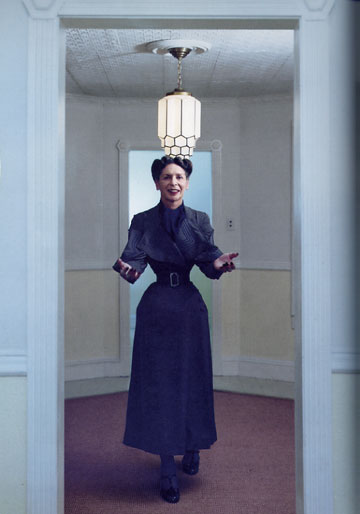|
|
 |
|

Matthew Barney is primarily known for his CREMASTER movies but he is also, within the course of his movie-making
process, able to produce elaborate sculptures and photographs as well. One particularly notable photograph is of the character
Baby Fay La Foe which is taken near the end of CREMASTER 2 in a section entitled 'The Royal Cell.' I have never seen any of
the CREMASTER movies but would like to consider this particular image of Baby Fay La Foe anyways as it works on its own accord
- apart from its original context and without reference to the storyline of the CREMASTER series.
The first thing we notice is that the image is a very simple one that consists only of an elderly woman
placed in a fairly barren interior. In this manner, Barney adheres to Van Gogh's principle "to exaggerate the essential
and to leave the obvious vague." The deceptive simplicity of the image actually disguises the enormous budget and effort
that was needed to create this entire piece. Indeed, the Rococo extravagance associated with the CREMASTER series has led
Hal Foster to refer to Barney as "Wagner for the MTV generation." On further inspection, we do begin to notice that
every detail has been attended to and we see that the hexagonal motif of a honeycomb cell is prevalent throughout the entire
composition - in the cornices of the doorways, in the light fixture, as well as in the shape of the entire room.
Overall, we have to admit that there is an eerie facade of insincerity that looms over this entire scene. The first thing
we immediately notice though, by far, is the abnormally thin waist that has been placed at the center of the entire composition.
Due to this unnatural thinness, right away the viewer recognizes that this woman is deeply concerned with appearances. Her
clothes seem somewhat dated as well but this only works to convincingly emphasize her warped fixed values. We are welcomed
with 'open arms' and Baby Fay La Foe has to surpass several passages to greet us. The viewer imagines that she is probably
coming from a more secluded wing of the household where perhaps more private secrets may lie. It is apparent, by virtue of
her body language, that this is her space and we are her guests. The symbolic gesture of her open arms is meant for us, the
viewer, as well as anyone who might be around to witness this welcoming. However, we immediately recognize that this woman,
by virtue of her freakish waist, goes to great lengths to create an appearance that she mistakenly perceives will make her
more admired. In fact, Baby Fay La Foe's attempts to embrace us are probably just another misguided attempt to get us to like
her more. We, however, cringe at the thought that we have to hug this superficial woman. Unless we are rude enough to reject
her and create an even more awkward scene, we also have to become superficial by giving our self to her and sharing an intimate
gesture with someone whom we do not particularly know or respect.
The open arms are only emphasized by her open palms which are, in turn, extenuated by the moldings on the
walls that extend from her hands and seem to try to wrap around us. While the walls of the intermediary room begin to engulf
us, they are abruptly confronted by the wall in front us that protects us only momentarily. As the corset conforms Baby Fay
La Foe's body, similarly, the architecture of the hallway conforms her body in a way that limits her physicality and prompts
her in a predetermined direction. The repetition of the passageways imply movement in the way something recedes away from
us as it moves off into the distance - we observe one passageway and when we move visually onto the next passageway it seems
as if we have somehow gotten further away. A sense of vertigo ensues. Baby Fay La Foe's movement towards us is only accentuated
by her vast step towards us. Perhaps this image would have been a bit stronger, though, without this dramatic step. If, instead,
Baby Fay La Foe had been standing still we would have felt obligated, by virtue of her open arms, to leave the comfort of
our space and enter into Baby Fay La Foe's lair which would precariously place us in the more vulnerable position of her domain.
Overall, there is a slight bluish cast to the image except for the strong white light in the main room that
has a conspicuous theatrical effect to it. With a suspension of disbelief, we presume that the light responsible for casting
the long shadow of the light fixture has it original source from an unusually placed window. The light is intended to seem
natural and, unlike the rest of the composition, it is therefore off-center and does not conform to the imposed order that
Baby Fay La Foe is able to tightly control her home and fashion with.
This particular aspect of Barney's films presented here reminds us of cinema's reoccurring interest in the
suburbs as seen in such movies as 'Blue Velvet,' 'Halloween,' 'Nightmare on Elm Street,' 'Poltergeist,' 'Edward Scissor Hands,'
'Pleasantville,' 'The Truman Show,' 'American Beauty,' 'Donnie Darko,' etc. Baby Fay La Foe seems to try hard to be the perfect
homemaker, a role associated with and relegated to the suburbs in the Fifties. Indeed, the green manicured lawns of the suburbs
often work to build a facade of normalcy that desperately attempts to hide the troubled secrets brewing within. The metaphorical
white-picket fence works perfectly here as the epitome of the picturesque barrier which Baby Fay La Foe seems to try to build
around herself.
|
 |
|
|
|
Barney has corresponding images of two other characters, a younger man and woman (Frank & Bessie Gilmore),
in similar compositions but which do not seem to work quite as well. Comparing these images together helps to discern what
makes Baby Fay La Foe's image so compelling. First off, we see the importance of the echoing second passageway in forming
a more complex and interesting environment. The picture of Frank Gilmore is particularly intriguing because he is not conforming
as much as he is reacting against today's social norms. Hips are a distinguishing feature of women and by playing on this
feminine aspect he is entering the realm of gender-bending and, by contemporary standards, he can be considered somewhat of
a transvestite despite the masculine connotations of his phallic tie. Because of Bessie Gilmore's plumpness, the hourglass
figure is not as dramatic on her and almost seems natural on the curvier, full-figured woman. It is apparent that Baby Fay
La Foe is an interesting character precisely because she takes the social values of thinness and femininity to the extreme.
It can, therefore, be interpreted that Baby Fay La Foe is simply perpetuating the patriarchal values dictated upon her as
this aging woman only struggles to maintain her good looks. While Baby Fay La Foe is now a victim of social laws here, we
are still unable to trust someone who does not see blatant abnormalities in their blind ambition to move up the social ladder
and become something they obviously are not. This phenomenon reminds us of cultish figures like Tammy Faye Baker who, with
their excessive makeup, exaggerate feminine allure to the point of grotesque. In these collective images, Barney demonstrates
how the social fashions presiding over the time truly shape the individual. Indeed, we are born naked yet in most cultures
it is illegal to remain in this most natural state of nudity. This only reinforces Jean-Jacques Rousseau's infamous observation
that "Man is born free, yet everywhere he is in chains."
In Barney's interview with ART 21 he reveals "I consider all the things I work with attractive to me
whether they repulse me or not - I still am very, very attracted to them." While we cannot describe Baby Fay La Foe as
particularly beautiful, we do have to admit that she stirs something within us. Barney's image is not beautiful, nor attractive
in the conventional sense, yet we are nevertheless attracted to it in a way that can only be described, in a very rough vernacular,
as a 'cool picture.' Because of aesthetics' historical marriage to beauty, art has too often ignored compelling experiences
not directly associated with the beautiful. The overall twentieth-century rejection of beauty, however, is not quite the answer.
Art, instead, has to make a concerted effort to expand its vocabulary to incorporate and articulate vital phenomenona that
have been silent henceforth. Intellectuals like Burke and Freud, for example, helped to streamline the aesthetic vocabulary
further when they attempted to explicate terms like 'the sublime' and 'the uncanny.' While it is not possible for a single
word to encompass the entire meaning of this photo, the term attractive should no longer simply be synonymous with the beautiful.
Even when we are repulsed by something, it is still attractive to us in a sense that it provokes something deep within our
own soul and Barney's images, therefore, are not merely creepy but are deeply relevant to what makes us most human and sincerely
deserve further investigation.

Thomas Cummins art philosophy
|
|
|
 |

